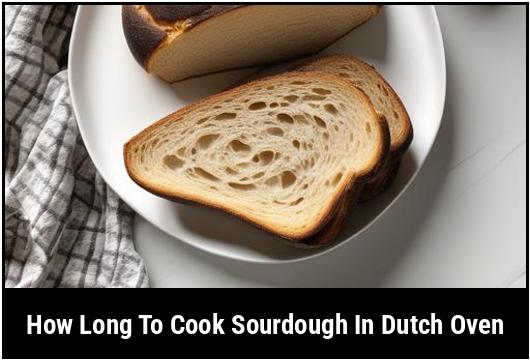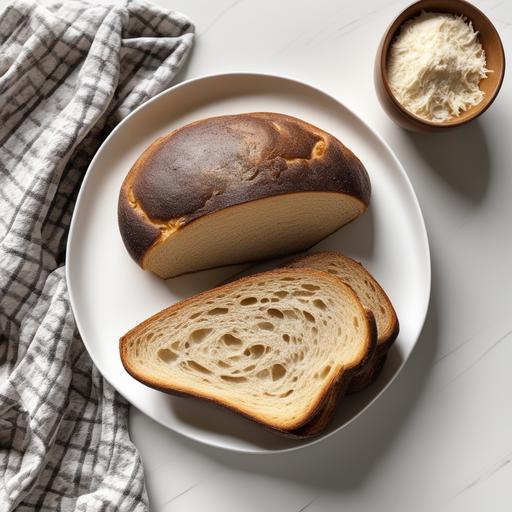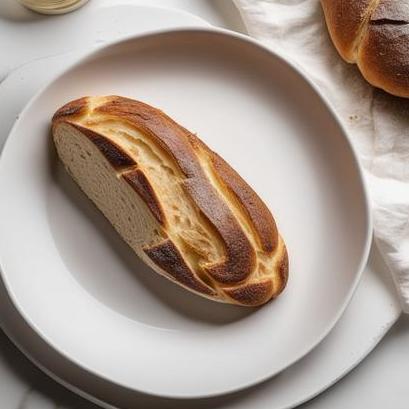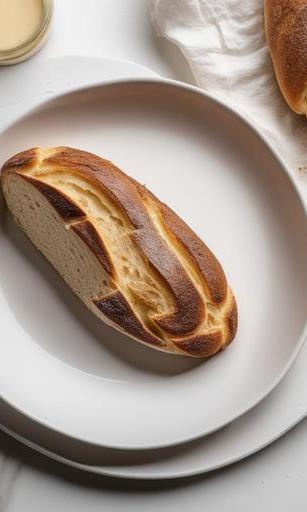[GUIDE] How Long To Cook Sourdough In Dutch Oven

Sourdough bread is loved by many for its delicious crust, unique flavors, and chewy texture. One of the keys to achieving a perfect sourdough loaf is cooking it in a Dutch oven. The Dutch oven creates a micro-environment within your oven, trapping steam and creating a beautiful crust. However, getting the cooking time right is crucial for the perfect loaf. In this article, we’ll explore the ideal cooking time for sourdough in a Dutch oven and discuss various factors to consider for achieving bakery-quality results.
Quick Answer: How Long To Cook Sourdough In A Dutch Oven
The average baking time for sourdough in a Dutch oven is about 45 minutes to 1 hour. However, this can vary depending on several factors such as the size of the loaf, the oven temperature, and the desired level of crustiness. It’s essential to monitor the bread closely during the cooking process to achieve the desired outcome.
Key Takeaways
- The average cooking time for sourdough in a Dutch oven is 45 minutes to 1 hour.
- Factors like loaf size, oven temperature, and crustiness preference can influence cooking time.
- Monitor the bread closely during cooking to ensure optimal results.
The Science Of Cooking Sourdough

To understand the ideal cooking time for sourdough in a Dutch oven, it’s important to understand the science behind the process. Sourdough bread is made from a fermented dough that contains wild yeast and bacteria. During the fermentation process, the yeast produces carbon dioxide, causing the dough to rise.
When bread is placed in a preheated Dutch oven, the trapped steam from the dough’s moisture creates a micro-environment within the pot. This steam helps to develop a crispy crust while keeping the interior of the bread moist and chewy. The Dutch oven’s ability to retain heat also promotes even cooking, resulting in bread with a uniform texture.
Choosing Sourdough
The first step towards achieving a perfectly cooked sourdough loaf is selecting the right recipe. There are countless sourdough recipes available, each with its own baking instructions. Look for a recipe that specifically mentions using a Dutch oven for baking. These recipes are designed to take advantage of the Dutch oven’s steam-trapping capabilities and will provide more accurate cooking times.
Preparing Sourdough

Before cooking sourdough in a Dutch oven, it’s crucial to properly prepare the dough. Here are a few essential steps:
-
Proofing: After mixing the ingredients, the dough needs to be proofed to allow for fermentation. Follow your specific recipe for the recommended proofing time.
-
Shaping: Once the dough has proofed, gently shape it into a round loaf. This step helps to create a good structure and control the spread of the dough during baking.
-
Final Proof: Place the shaped dough in a proofing basket or a well-floured kitchen towel for the final rise. This step should be done at room temperature for the recommended time specified in your recipe.
-
Preheating the Dutch Oven: While the dough is on its final proof, it’s time to preheat your Dutch oven. Place the pot with its lid on in the oven and heat it to the desired baking temperature. Preheating the Dutch oven ensures that it is hot and ready for the dough when it’s time to bake.
Ideal Cooking Temperature For Sourdough
The ideal cooking temperature for sourdough in a Dutch oven is typically around 450°F (230°C). This high temperature allows for a good oven spring (the rapid rise of the dough in the initial stage of baking) and helps to develop a crispy crust.
Sourdough Cooking Time

The cooking time for sourdough in a Dutch oven can vary depending on several factors, including the size and shape of the loaf, the oven temperature, and the desired level of crustiness. Here are some general guidelines to help you estimate the cooking time:
-
Regular-sized Round Loaf: A typical round loaf of sourdough with a weight of around 500 grams (1.1 pounds) may take 45 minutes to 1 hour to cook. This time frame allows for a well-browned crust and a fully baked interior.
-
Oval or Batard Loaf: Long, oval-shaped loaves of sourdough may require slightly longer cooking times compared to round loaves. The elongated shape and increased volume often result in a denser crumb, needing a bit more time to bake through.
-
Large Loaf or Multiple Loaves: If you’re baking a larger loaf or multiple loaves in one Dutch oven, you’ll likely need to increase the cooking time. The extra mass of dough requires more time to heat through adequately.
It’s important to note that these times are approximate and should be used as a starting point. Variations in your specific recipe, oven, and personal preference may require adjustments.
Cooking Techniques
To ensure an evenly cooked and well-risen sourdough loaf, there are a few cooking techniques worth considering:
-
Preheating the Dutch Oven: As mentioned earlier, preheating the Dutch oven is crucial for achieving a crispy crust and even cooking. Make sure to heat the Dutch oven with the lid on at the desired baking temperature.
-
Slashing the Dough: Just before placing the dough in the Dutch oven, make several shallow slashes on the surface. These slashes help to release excess steam during baking and prevent the bread from bursting open in undesirable areas.
-
Steaming the Dutch Oven: To create that perfect crust, you need to trap steam inside the Dutch oven. This can be achieved by spritzing the dough with water just before slashing it or by placing a small tray with water at the bottom of the oven. The steam will help the dough expand quickly and create a crisp exterior.
Monitoring And Troubleshooting

Throughout the cooking process, it’s important to closely monitor the bread to ensure optimal results. Here are a few key things to watch for:
-
Oven Spring: Watch for a significant rise in the dough during the first 10-15 minutes of baking. This is known as the oven spring and indicates that the dough is properly fermenting and expanding.
-
Browning: As the sourdough bakes, keep an eye on the crust’s color. A well-browned crust is desirable, but be cautious not to let it become too dark or burnt. Adjust the oven temperature if necessary to prevent over-browning.
-
Internal Temperature: One of the most accurate ways to determine if your sourdough is cooked is by measuring its internal temperature. The ideal internal temperature of a fully baked sourdough loaf is around 200°F (93°C). Use a kitchen thermometer to check the temperature by inserting it into the middle of the loaf.
Sourdough Cooking Instructions
Now that we’ve discussed the factors involved in cooking sourdough in a Dutch oven, let’s go through an example step-by-step cooking process:
-
Preheat the Dutch oven: Place the Dutch oven with its lid on in the oven and preheat it to 450°F (230°C).
-
Slash the Dough: Just before baking, gently slash the surface of the proofed dough with a sharp knife or a bread lame. Make shallow cuts, about 1/4-inch deep, to help the bread expand during baking.
-
Transfer Dough to Dutch Oven: Remove the preheated Dutch oven from the oven and carefully place the dough inside. Be cautious as the pot and lid will be extremely hot.
-
Bake with Lid On: Cover the Dutch oven with its lid and return it to the oven. Bake for the first 20-25 minutes with the lid on. This allows the bread to steam and rise.
-
Remove Lid and Continue Baking: After the initial steaming period, remove the lid and continue baking for another 20-25 minutes, or until the crust is well-browned and the internal temperature of the bread reaches around 200°F (93°C).
-
Cool and Enjoy: Once fully baked, carefully remove the sourdough loaf from the Dutch oven and place it on a wire rack to cool completely before slicing.
Variations

The cooking time can vary depending on the size and shape of your sourdough loaf. Here are a few variations to consider:
-
Longer, Slender Loaves: For longer, slender loaves like baguettes, reduce the cooking time since the dough is thinner and requires less time to bake through.
-
Rolls or Mini Loaves: If you’re baking smaller rolls or mini loaves, reduce the cooking time accordingly. The smaller size will bake faster than regular-sized loaves.
Remember to adjust the cooking time based on the specific characteristics of your dough to ensure even cooking and prevent over or under baking.
When Things Go Wrong
Despite your best efforts, it’s possible for things to go wrong during the sourdough cooking process. Here are a few common issues and potential solutions:
-
Pale Crust: If your crust ends up pale and lacks deep browning, try increasing the oven temperature slightly or extending the cooking time with the lid off.
-
Gummy or Dense Interior: A gummy or dense interior may indicate that the bread is undercooked. Increase the cooking time or lower the oven temperature slightly to ensure proper baking.
-
Excessively Dark Crust: If the crust is becoming too dark or burnt, reduce the oven temperature or cover the loaf with aluminum foil during the last part of the cooking process to prevent further browning.
Serving Sourdough

Once your sourdough is perfectly cooked, it’s time to enjoy your delicious creation! Allow the bread to cool completely on a wire rack before slicing into it. This cooling time allows the interior to set fully, resulting in a better texture.
Sourdough can be served in various ways – toasted with toppings, used for sandwiches, or simply enjoyed with butter or olive oil. The crusty exterior and tangy flavor make it a versatile and tasty bread option.
Best Practices For Sourdough Cooking
To achieve consistently excellent results when cooking sourdough in a Dutch oven, here are a few best practices to keep in mind:
-
Follow Your Recipe: Make sure to carefully follow the instructions provided in your chosen sourdough recipe. Each recipe may have specific variations and requirements that can influence cooking time.
-
Maintain Consistent Oven Temperature: A consistent oven temperature is crucial for even baking. Use an oven thermometer to ensure your oven is accurately set to the desired temperature.
-
Experiment and Learn: Baking sourdough is a learning process. Don’t be afraid to experiment with different techniques, temperatures, and cooking times to find what works best for you and your specific sourdough recipe.
-
Practice Patience: Baking sourdough takes time and patience. Allow your dough to proof properly, preheat the Dutch oven thoroughly, and avoid rushing the cooking process.
Conclusion
Cooking sourdough in a Dutch oven is a fantastic way to achieve bakery-quality results at home. With the right techniques and knowledge, you can achieve a perfectly cooked loaf with a crispy crust and a moist, chewy interior. Remember to consider factors like loaf size, oven temperature, and desired crustiness level when determining the cooking time. As you gain experience and experiment with different recipes, you’ll develop a better understanding of how long to cook your sourdough in a Dutch oven to achieve the perfect loaf.
FAQS
What Is A Sourdough?
Sourdough is a type of bread made from a mixture of flour and water that is fermented naturally using naturally occurring wild yeast. It is often referred to as the "traditional" way of making bread.
What Kind Of Dutch Oven Should I Use To Cook Sourdough Bread?
It is recommended to use either cast iron or enameled cast iron Dutch ovens since they distribute heat evenly and maintain a consistent temperature throughout cooking, which is ideal for sourdough bread.
How Does Cooking Sourdough Bread In A Dutch Oven Improve It?
Cooking sourdough bread in a Dutch oven can help retain moisture, which, in turn, creates a superb crust and texture. It also helps trap the steam that’s produced by the dough and enhances the flavor of the bread.
How Long Does It Take To Cook Sourdough In A Dutch Oven?
Generally, baking sourdough bread in a Dutch oven takes around 45 to 60 minutes, depending on the size of the bread and the oven temperature. It’s important to note that the temperature and timing may vary depending on the recipe you’re using and the oven you have.
Can I Cook Sourdough In A Dutch Oven Without Preheating It?
Preheating your Dutch oven is critical for baking sourdough bread. This is because, when you put the dough in a preheated Dutch oven, it immediately starts to bake and rise. Therefore, skipping this step may result in a dense and undercooked loaf.
Sources
About the Author Jenny
I'm Jenny, a housewife with an unwavering passion for food. My culinary journey began with my grandmother's kitchen, and it's now a full-fledged food blog. I've turned my love for cooking into a creative outlet, sharing recipes and stories with a global community of fellow food enthusiasts. It's proof that being a housewife can also mean pursuing your passions and savoring life's delectable moments.
